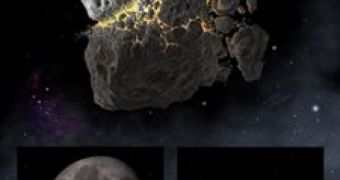A breakup in the asteroid belt of the Sun System has now been connected by an American-Czech team from Southwest Research Institute (SwRI) and Charles University in Prague to the catastrophic event that destroyed the dinosaurs and many contemporaneous species 65 million years ago, after combining observations with various numerical simulations.
The parent object of asteroid (298) Baptistina exploded when it was hit by another large asteroid, resulting large chunks that would later impact the Earth in the Chicxulub crater on the Yucatan Peninsula as well as Moon on the prominent Tycho crater.
Baptistina had about 170 km (108 mi) in diameter and was similar to carbonaceous chondrite meteorites, being located in the innermost area of the asteroid belt when collided with another asteroid of about 60 km (37 mi) in diameter and thus resulting the Baptistina asteroid family, a group of asteroid fragments with similar orbits.
At the beginning, the family was made of approximately 300 bodies over 10 km (6 mi) and 140,000 bodies over 1 km (0.6 mi). The new fragments' orbits started to change gradually due to thermal forces resulted from the absorbed and re-radiated sun heat. "By carefully modeling these effects and the distance traveled by different-sized fragments from the location of the original collision, we determined that the Baptistina breakup took place 160 million years ago, give or take 20 million years." said co-author Dr. William Bottke (SwRI).
Gradually, the fragments drifted into a nearby "dynamical superhighway", getting out of the main asteroid belt and reaching orbits that crossed Earth's path.
ComputCer simulations showed that about 20 % of the large fragments in the Baptistina family were lost this way and 2 % could have struck the Earth.
This is supported by the impact history of the Earth and Moon, with a two times increase in the appearance of large craters between 100 to 150 million years.
"The Baptistina bombardment produced a prolonged surge in the impact flux that peaked roughly 100 million years ago. This matches up pretty well with what is known about the impact record." said co-author Dr. David Nesvorny (SwRI).
"We are in the tail end of this shower now. Our simulations suggest that about 20 % of the present-day, near-Earth asteroid population can be traced back to the Baptistina family." added co-author Dr. William Bottke (SwRI)
The 180 km (112 mi) diameter Chicxulub crater has been connected to the extinction of the dinosaurs 65 million years ago and analyses showed that the Chicxulub impactor had a carbonaceous chondrite composition similar to the primitive meteorite Murchison, eliminating most potential impactors but not the Baptistina ones.
Computer simulations revealed a 90 % probability that the impactor of the Chicxulub crater belonged to the Baptistina family and a 70 % probability that the Moon's crater Tycho crate, 85 kilometer (51 m) wide and 108 million years old, was the result of the collision with a large Baptistina fragment. Tycho's prominent rays extend as far as 1,500 km (900 mi) across the Moon.
"The probability is smaller than in the case of the Chicxulub crater because nothing is yet known about the nature of the Tycho impactor." said co-author Dr. David Vokrouhlicky (Charles University, Prague).
"It is likely that more breakup events in the asteroid belt are connected in some fashion to events on the Earth, Moon and other planets," said Bottke.

 14 DAY TRIAL //
14 DAY TRIAL //